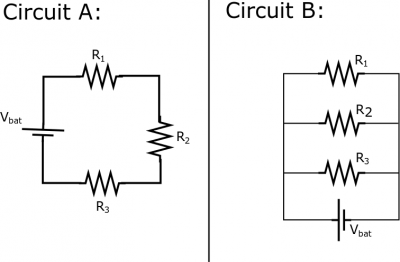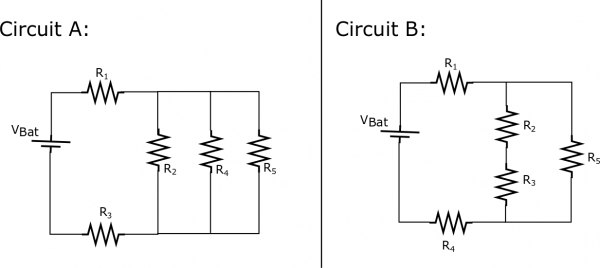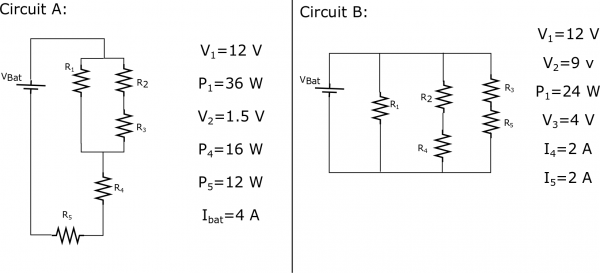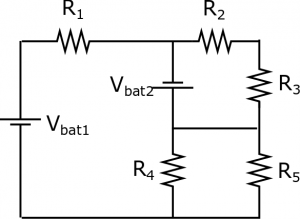Project: Circuit Test Part 1
Kick Off Questions
- What are the loop & node rules? What physical principles do they relate to?
- The equation for power can be written in 3 different ways - what are the 3 ways & how do you get them?
- Conceptually, what is current? Why do we usually say “current through a resistor”?
- Conceptually, what is voltage? Why do we usually say “voltage across a resistor”?
Main Problem
Your boss thinks FTOE needs to hire additional staff in order to get the hawkion accelerator working again. Someone named Solomon Tobb has applied for a job, but she's unsure of his qualifications. She's written up a screening test to evaluate his knowledge of circuit analysis, but she didn't have time to write the answer key so she's asked you to do it. The test has several levels, and she'd like you to complete as much of the solution key as you can.
Level 1: Basic Combos
For the circuits below, say that $V_{bat} = 5 \;{\rm V}$, $R_1 = 2 \;\Omega$, $R_2 = 3 \;\Omega$, and $R_3 = 4 \; \Omega$. For each circuit below,
a) What is the equivalent resistance of the circuit?
b) Which resistor would have the largest voltage drop?
c) Which resistor would have the smallest current?
Level 2: Equal circuit elements
For the circuits below, say that $V_{bat} = 16 V$ and each resistor is $R = 150 \Omega$. For each circuit,
a) What is the equivalent resistance of the circuit?
b) Which resistors are in series? Which resistors are in parallel? How do you know?
Level 3: Resistor Circuits
For the circuits below, you have been given some of the quantities for various elements around the circuit. For example, $V_1$ would correspond to the voltage across Resistor 1. For each circuit,
a) Which resistors are in series and which resistors are in parallel? How do you know?
b) Find all the missing quantities for each resistor (R, V, I, and P).
c) What is the voltage, current, and power provided by the battery in your circuit?
d) If the resistors in the circuit were lightbulbs, which would be the brightest?
Level 4: Challenge Mode
For the circuit below, say that $V_{bat1} = 9 V$, $V_{bat2} = 6 V$, and all resistors are $R = 100 \Omega$. For the circuit below,
a) Are there places in your circuit that can simplify? (AKA resistors in series or in parallel?)
b) Redraw the circuit after making the simplifications that you can.
c) How many different currents do you have in your circuit? Draw and label this on your picture. What node rule equations can you make?
d) How many different loops do you have in your circuit? What loop rule equations can you make?
e) Solve for your unknown currents. Note: you can use Wolfram Alpha or other resources online to solve the system of equations.
Learning Goals:
- Explain how you know something is in series. Explain what happens for current & voltage when resistors are in series.
- Explain how you know something is in parallel. Explain what happens for current & voltage when resistors are in parallel.
- Explain what the loop rule is and the physical principle it is related to.
- Explain what the node rule is and the physical principle it is related to.
- Apply V = IR & P = IV to solve for any unknown quantities in the circuit (P, I, V, & R).
- Calculate the total combined resistance for a given circuit.
Wrap Up Questions
- What are the circuit rules that you used to solve these circuits? When did you use each of them?
- How do you know if something is in series or parallel (or neither)? What happens to current & voltage in each of those cases?
- What assumptions did you make when solving these circuits? (Hint: there are at least 3 big ones.)
- What order of magnitude is “normal” for voltage? (In other words, what are typical voltages you would encounter in the real world?)
- What order of magnitude is “normal” for current? (In other words, what are typical currents you would encounter in the real world?)
- What order of magnitude is “normal” for power? (In other words, what are typical powers you would encounter in the real world?)



